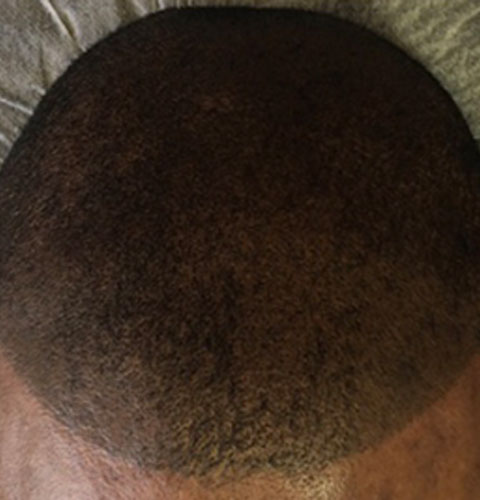When we refer to hair loss, we commonly talk about hair loss on the scalp rather than the entire body. The issue is more prevalent among men than women, who typically start losing hair as early as during their twenties. The medical term for the condition is called alopecia, and it can occur due to multiple reasons.
Hair loss is often hereditary, but other medical conditions such as hypothyroidism can cause excessive shedding or the hair becoming brittle. Due to the lack of iron they receive, anemic patients also suffer from hair damage. In general, alcohol consumption and a poor diet are also a factor that leads to the loss of hair, due to the hair not receiving the proper nutrients they require for maintenance and growth. A condition called telogen effluvium, induced by excessive stress on the body is also a significant factor for hair loss. It can be triggered during severe illness, excessive exercise or after an unfortunate event that can cause PTSD.
Image filename: a-man-with-micropigmentation
Image alt text: Close up of a man’s head with micropigmentation.
Hair is an important feature of our aesthetic, and the lack of it is generally a cause of insecurity among men and women. To remedy the thinning or loss of hair, people try different hairstyles, wigs and even surgical treatments to make up for the deficit. Unfortunately, most of the alternatives in the market are either very costly or have some drawbacks. The safest alternative, however, has been scalp micropigmentation.
What is Scalp Micropigmentation?
Scalp micropigmentation refers to the process of depositing pigments to the scalp to give the appearance of hair. Using a microneedle, the pigment is deposited on the recipient’s scalp, similar to how a tattoo works. The pigment used in the process is safe for use on the skin and has no repercussions, composed of natural, organic items.
The procedure is generally lengthy and depends on the amount of work required to hide patches of lost hair and the density of pigments to be deposited. The process doesn’t cause the hair to grow back, unlike a hair transplant, but it is a much safer, cost-effective solution that guarantees success.
The Procedure
The first step is to get a consultation with an SMP professional to find out whether you’re the right candidate for the treatment or not. There’s a chance that your hair may grow back, and you might not need the treatment at all.
Afterward, the consultant will recommend a pigmentation that fits with your existing hair. There’s no one size fits all solution, and the hair color varies from person to person, so this will give you something that fits your appearance. The recipient may also discuss any concern or goal they may for the design.
The First Session
Once the preliminary phase is over, the pigmentation deposit procedure begins. In the first session of the treatment, a new hairline is created, or adjustments are made to the existing one. The initial layer is laid, which acts as a foundation for the sessions to follow. The client can also request a certain hairline style and discuss with the consultant whether it would fit them or not.
Letting all the pigments settle in, the client is advised to allow the scars and scabs to heal over time before the second session can begin.
The Second Session
The consultant will observe how the skin reacts to the treatment, how the scabs have healed. After this, they will begin to add more individual pigments to the scalp to give the illusion of a fuller head. The pigments are more spread out to hide the scalp, covering gaps with the color.
The Third Session
Any concerns or queries that the client has during the procedure can be addressed at this point. The consultant will finish the treatment in the third session, adding any details to ensure an excellent job.
If the client requests any additional work on their hairline, they can request further sessions after a few months have passed by.
Image filename: back-of-head-micropigmentation
Image alt text: Back of a man’s head with micropigmentation done on it.
Aftercare for SMP Treatment
DAY 1 – 4:
Once the treatment is complete, you will feel the urge to touch your head or wash it, but it is important to resist the temptation. During this period, there will be scabs on your scalp from the pigment deposits, which require healing to settle on the scalp. Avoid moisture on your scalp at all costs, which means you cannot swim, take a shower, or engage in any exercise that could cause excessive sweating.
DAY 5 -7:
The pigments may start to settle in for the most part, but there will be scabs around the scalp that shouldn’t be scratched or disturbed. By now, you can start to take showers, but use only cold water to wash your head. Hot water can open up pores due to exfoliation, which can be unpleasant for the pigments settling on the scalp.
You can exercise now, just making sure that there isn’t any excessive sweating around the scalp. Avoid shaving your head altogether at this point, as it can pop off any scalps and ruin the effects of the treatment on that part.
DAY 7 and onward:
At this point, most of the scabs on your head will have healed, and the pigments settled in. The restrictions previously applied will no longer be applicable, and you can go about your routine without the fear of ruining any pigments.
Conclusion
While it is only an aesthetic change compared to other solutions that can effectively grow actual hair, due to its economic feasibility and the low risk attached to it, scalp micropigmentation is an effective solution. It has seen a great deal of popularity over the years for these reasons, with even notable personalities like Vin Diesel, Jason Statham and Jamie Foxx acquiring SMP hair treatment, which is only a testament to how effective and successful the solution is.
Delaware Scalp Micropigmentation provides hair micropigmentation for men and women to give them back their lost confidence and self-esteem by providing them with a new look. Reach out to us for an appointment today.

